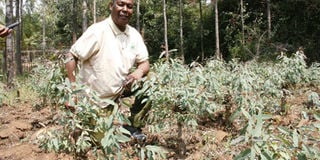Why you must plant eucalyptus this year

A farmer prunes his young eucalyptus trees. File photo
What you need to know:
- Eucalyptus can grow well across all the agro-ecological zones, ranging from the lowland to the mountainous highlands, writes Sylvans Ochola.
- Plant eucalyptus in areas that have been degraded by soil-erosion, marginal lands, waterlogged areas (for the purpose of draining the area), areas with saline soils and they can act as windbreakers on large farms.
Eucalyptus is the tree species of choice for many commercial farmers because it is multipurpose, fast-growing and has a ready market.
Its wide range of products such as firewood, charcoal, building materials, fencing posts, transmission poles, pulpwood, timber and plywood makes the genus versatile.
Agronomists’ advice
Agronomists recommend that eucalyptus should not be planted in riparian or marshy areas, wetlands, and near a water body.
Also, the trees should not be planted near buildings or on road reserves as the branches and stems of some species easily break off.
Plant eucalyptus in areas that have been degraded by soil-erosion, marginal lands, waterlogged areas (for the purpose of draining the area), areas with saline soils and they can act as windbreakers on large farms.
Eucalyptus can grow well across all the agro-ecological zones, ranging from the lowland to the mountainous highlands.
However, growing eucalyptus in low rainfall areas should be avoided as they can have a negative impact on the environment by competing for water with other species (especially food crops) and increased production of some exudates (allelochemicals) that may suppress the growth of the plants in the proximity.
Several factors greatly influence the yield of eucalyptus tree per unit area. Key among them are the choice of species, nursery management, pests and diseases incidences and management and the general management regime that is employed.
Factors influencing cultivation
Seeds sown in the nursery take between 7-14 days to germinate. When the seedlings are at the two-leaf stage, they should be pricked out into individual containers or polyethylene sleeves.
Proper fertiliser/manure use is recommended for healthy and vigorous seedlings.
For the period the seedlings will be in the nursery, they should be protected from excess sunlight, strong winds, weeds, pest and diseases.
The seedlings should also be watered (every morning and evening), with care being taken to avoid waterlogging.
Routine root pruning (at least twice) should also be practised especially if the seedlings are grown in open pots.
The seedlings should be maintained in the nursery until when they have attained a plantable height of 25-35cm, approximately 4-5 months later.
Planting and husbandry
The spacing during field establishment determines the final tree population per unit area of land.
The spacing is determined by the intended use and the agro-ecological region (mainly water availability).
In high potential areas, and with timber, transmission and construction poles in mind, a spacing of 2-2.5m by 2-25m is ideal, while in arid and semi-arid areas, the spacing should be increased to 3m by 3m to reduce excessive competition for water.
The transplanted seedlings require nurturing to reduce competition with weeds for water, nutrients, and sunlight.
Routine scouting for pests and diseases and effective control should also be conducted primarily during the first two years.
Most eucalyptus species are self-pruning, hence pruning that can lead to injuries and subsequent spread of diseases should be avoided.
Pests and diseases
As mentioned earlier, the first two to three years after transplanting are important as far as pests and diseases are concerned.
For this purpose, routine pest and disease scouting should be practised.
The most common and important insect pests include Blue gum chalcid, aphids, snout beetles, and termites. Blue gum chalcid is a severe eucalyptus insect pest that results in galls on the foliage and tender growing points, thus affecting growth.
The pests can be controlled using insecticides. Diseases can be controlled by spraying using appropriate chemicals.
Species
The choice of eucalyptus species to produce commercially will depend on the target market or the intended purpose.
For timber, transmission and construction poles, go for species such as E. grandis, E. saligna, E. globulus, E. hybrids, E. paniculata or E. camandulensis.
However, all species of eucalyptus can be used as a source of fuel wood, charcoal, fibre and for apiculture.
Maturity and harvesting
Maturity and ideal harvesting age are dependent on the intended purpose or market. The harvesting age significantly varies from three to four years (construction poles), eight to 15 years (transmission poles) to as late as 15-20 years for timber production.
Age at which the trees can be harvested is significantly dependent on the intended purpose and the market demand.
The time the tree takes to reach harvestable maturity should, therefore, not scare potential eucalyptus tree producers from the investment.
Currently a mature eucalyptus pole cost between Shs150,000 and Shs200,000 depending on its height.




